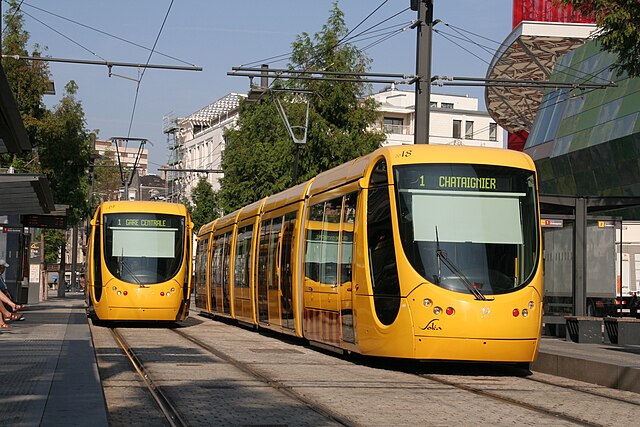Top Qs
Timeline
Chat
Perspective
Alstom Citadis
Family of low-floor trams and light rail vehicles From Wikipedia, the free encyclopedia
Remove ads
The Alstom Citadis is a family of low-floor trams and light rail vehicles built by Alstom. As of 2017[update], over 2,300 Citadis trams have been sold and 1,800 tramways are in revenue service throughout the world, with operations in all six inhabited continents.[1] An evolution of Alstom's earlier TFS vehicle, most Citadis vehicles are made in Alstom's factories in La Rochelle, Reichshoffen and Valenciennes, France, and in Barcelona, Spain, and Annaba, Algeria.[2]


Remove ads
Citadis types
Summarize
Perspective
The Citadis family includes both partial and fully low-floor trams and LRVs. Several version are of the multi-articulated design with alternating wheeled and suspended sections. These were built with three (20x), five (30x), seven (40x), and nine (50x) sections. The whole line up comprises the following standard variants:
Urban tramway vehicles

- Citadis X00
- Citadis 100 – three section, 70% low floor, originally designed and manufactured by Konstal in Chorzów for the Polish market (Katowice, Gdańsk)
- Citadis X01 (first generation)
- Citadis 301 – three section, 70% low floor (Orléans)
- Citadis 301 CIS – 100% low floor version with IPOMOS bogies on 1,524 mm (5 ft) gauge (Moscow, Saint-Petersburg[3]). Also designated 71-801 according to the Russian unified system of rolling stock classification (71=trams, 8=manufacturer code (Alstom), 01=model code).
- Citadis 401 – five sections, 70% low floor (Montpellier and Dublin, some converted from 301s)
- Citadis 301 – three section, 70% low floor (Orléans)
- Citadis X02 (second generation)
- Citadis 202 – three section, 100% low floor (Melbourne)
- Citadis 302 – five sections, 100% low floor (Algiers, Adelaide, Angers, Lyon, Bordeaux, Paris T2, T7 and T8, Valenciennes, Rotterdam, Buenos Aires, Madrid, Melbourne, Nice, Murcia, Barcelona, Jerusalem, Le Havre, Tenerife and Nottingham)
- Citadis 402 – seven sections, 100% low floor (Bordeaux, Grenoble, Lyon, Paris T3, Dubai, Rio de Janeiro, Oran, Constantine)
- Citadis 502 – nine sections, 100% low floor (Dublin, some converted from 402s)
- Citadis X03 (third generation)
- Citadis 403 – seven sections, 100% low floor (Strasbourg)
- Citadis X04 (fourth generation)
- Citadis 304 – 100% low floor, next generation design for Central and Eastern Europe (Istanbul)
Light-rail transit vehicles
- Regio-Citadis – three sections, 70% low floor LRV (Kassel, The Hague)
- Citadis Dualis – four or five sections, 100% low-floor LRV (operated by the SNCF,[5] see below)
- Citadis Spirit – three or four sections, 100% low floor LRV designed for the North American market (Ottawa's Line 1, Toronto's Line 6)[6][7][8]
Power supply
Like most trams, Citadis vehicles are usually powered by overhead electric wires collected by a pantograph, but the trams in several places do not use pantograph current collection entirely.
The most popular solution is Alstom's proprietary ground-level power supply (APS, first used in Bordeaux and subsequently in Angers, Reims, Orleans, Tours, Dubai, Rio, Barcelona, and Sydney), consisting of a type of third rail which is only powered while it is completely covered by a tram so that there is no risk of a person or animal coming into contact with a live rail. On the networks in France and in Sydney, the trams switch to conventional overhead wires in outer areas,[9] but the Dubai vehicles are the first to employ APS for its entire passenger length (although they are still equipped with pantographs for use in the maintenance depot).
Another option is to use on-board batteries to store electrical power, allowing brief periods of catenary-free operation without the need to install special infrastructure. The Citadis trams in Nice operate off a set of nickel metallic hydride batteries in two large open spaces where overhead wires would be an eyesore.[10] This has since been superseded by a supercapacitor-based energy storage system (SRS)[11] which is in use in Rio de Janeiro (alongside APS), Kaohsiung, and along a new line in Nice. The Regio-Citadis can also be built as a dual-voltage or electro-diesel vehicle with various configurations.
Remove ads
Ordered Citadis trams
Summarize
Perspective
Africa
Asia
North America
The main article provides vehicle and order descriptions.
South America
Middle East
Europe
Oceania
Remove ads
See also
References
External links
Wikiwand - on
Seamless Wikipedia browsing. On steroids.
Remove ads

















































































